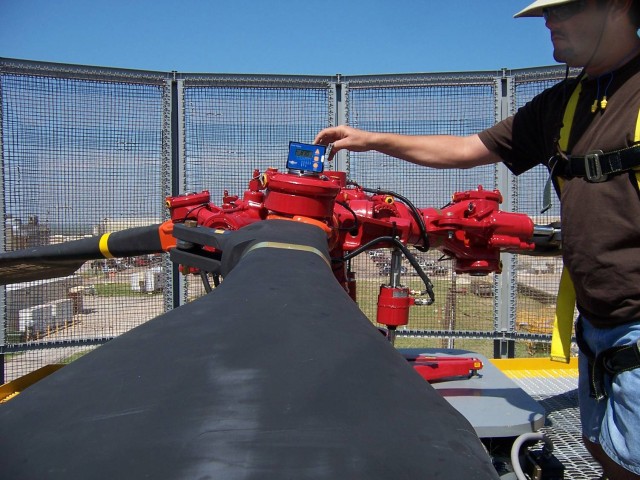CORPUS CHRISTI ARMY DEPOT, Tx. - A group of Soldiers flying to an undisclosed location suddenly come under enemy fire. The crew, adeptly trained in maneuvering during combat, navigates their Chinook to safety, but emergency landings can get a little rough. Not soon after the helicopter is struck, the CH-47 abruptly hits the ground. Dust flies, as the Chinook's creaking comes to a halt. Slowly, the Soldiers in the damaged Chinook shuffle to their feet. The pilot asks, "Everyone okay'" All are safe. The pilot exits the aircraft and starts surveying the damage sustained by the hard landing: "How are the rotor blades'"
Rotor blades for the CH-47 are in short supply, especially the aft rotor blades. If the rotor blades of a damaged Chinook are in workable condition, they are removed from the damaged aircraft and transferred to one that is functioning. Even without crashes or hard landings, these rotor blades suffer from heavy workloads; frequent usage and environmental factors. Increased operational tempo has necessitated a more efficient overhaul of CH-47 rotor blades to sustain the Soldiers' needs on the field.
Chinooks are unique to the rotorcraft family as a tandem rotor, heavy-lift helicopter. The aircraft specialize in moving troops and large quantities of materials on the battlefield. They also specialize in disaster relief, rescue, and medical evacuation, to name a few.
This is an important helicopter, especially in the global war against terror. Capable of handling loads of up to 24,000 lbs with a maximum gross weight of 50,000, its large size also makes the Chinook instantly recognizable to civilians throughout the world. The size is not the only thing that sets the Chinook apart. The aft rotor blades, unlike forward blades, have a clockwise spin while all other blades rotate counter-clockwise.
"There's no other blade like it," notes Roy Hollins, the director of Components Production at CCAD.
The aft rotor blade's distinctive clockwise spin offers a special challenge to those who would repair them for the warfighter.
Hollins is part of a talented team of individuals at CCAD, who have stepped up to the plate to ensure the rotor blades are being properly repaired and returned to the warfighter. I n September 2007, CCAD began the repair and overhaul of CH-47 blades.
CCAD's main task is to overhaul, repair, retrofit, test, and otherwise modernize helicopters, engines, and components. The standard procedures for repairing aircraft blades include the repair of the blade, a static balance on a teeter stand, and dynamic testing and balance. If the blades succeed in those areas, they are then sold to the fleet.
To help get the helicopters back to the warfighter sooner, CCAD made some changes to accommodate the unique aspects of the Chinook overhaul process. CCAD had to be qualified for 42 different repair procedures and receive several different certifications.
For instance, employees had to obtain certification for stripping paint from Chinook rotor blades using plastic media blasting. Before PMB was used at the depot, blades took one to one and a half days to be hand-blasted. But this process does not work with the Chinook, which needs plastic media blasting.
"After gaining certification from Boeing's approved source," said Fred Koch, chief of Materials and Process Engineering at CCAD, "[employees at Materials and Process Engineering) prepared a PMB training manual, written exam, and operations manual which we will use to certify our own personnel in the future."
Now, with PMB, blades can be blasted a fraction of the time.
CCAD also required NADCAP certification, both in ultrasound and radiography. And blade mechanics received training in order to acquaint themselves with a new set of equipment specifically for that purpose. Pointing to some CH-47 rotor blades in the blade shop, aircraft mechanic, Arthur Palumbo explains, "These blades took three to four months to repair." Typical rotor blade repair doesn't take this long, but mechanics had to understand the new repair requirements and adapt/develop their processes to become qualified for Chinook rotor blade repair.
On Feb. 19, 2009, after months of orientation and training, CCAD received formal approval for blade overhaul qualification and became a qualified Boeing vendor. "Knowing we have the capability to help [the Chinook rotor blade] situation is phenomenal," said Depot Commander, Col. Dunaway, clearly proud of the CCAD's achievement.
The people at CCAD obviously have pride in the work they do, and teamwork is a constant theme that runs through it. The major reason for success, Roy Hollins said, was due to the teamwork involved throughout CCAD.
"Everybody had to do their part and they came together for it. Just about every support directorate was involved in supporting this effort." Bob Straiton, the Business Development Office chief, who worked closely with this project, laughed as he said that a list of the people involved would appear more like the end credits to a feature-length film.
Business Development Specialist, Roderick Benson was very pleased with what this extra capability means for the depot.
"The more we have here, the more important we are to the Warfighter."
In the end, remembering those that are out there making daily sacrifices for our freedom makes it all worth it.


Social Sharing